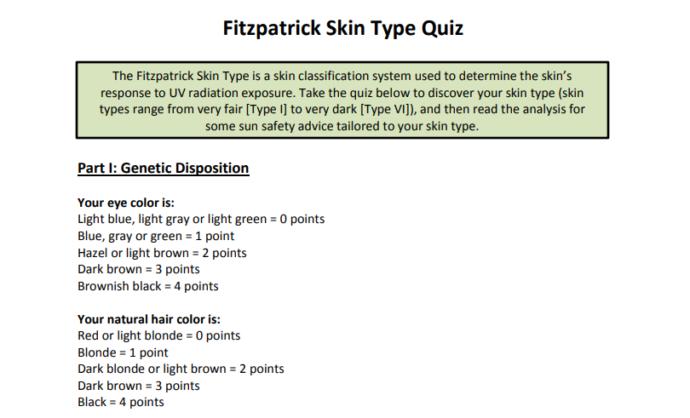Take Fitzpatrick quiz to find out your skin type, then 'vote' for what you got as your skin type.





IVORY - Skin Type I (0-6 points): Your skin always burns and never tans in the sun. You are extremely susceptible to skin damage as well as cancers like basal cell carcinoma, squamous cell carcinoma, and melanoma (the deadliest type of skin cancer). Seek shade when you are out in the sun. Cover up as much as possible with a hat, sun-protective clothing, and sunglasses. Wear a broad-spectrum sunscreen with SPF 30+. Check your skin head-to-toe each month. Tell your healthcare provider about any suspicious growths, and have an annual professional skin exam.

FAIR - Skin Type II (7-12 points): Your skin almost always burns and rarely tans in the sun. You are highly susceptible to skin damage as well as cancers like basal cell carcinoma and squamous cell carcinoma. You are also at high risk for melanoma (the deadliest type of skin cancer). Seek shade when you are out in the sun. Cover up as much as possible with a hat, sun-protective clothing, and sunglasses. Wear a broad-spectrum sunscreen with SPF 30+. Check your skin head-to-toe each month. Tell your healthcare provider about any suspicious growths, and have an annual professional skin exam.

MEDIUM - Skin Type III (13-18 points): Your skin sometimes burns and sometimes tans in the sun. You are susceptible to skin damage as well as cancers like basal cell carcinoma and squamous cell carcinoma. You are also at risk for melanoma (the deadliest type of skin cancer). Seek shade between 10 AM – 4 PM, when the sun is strongest. Cover up with a hat, sun-protective clothing, and sunglasses. Wear a broad-spectrum sunscreen with SPF 30+. Check your skin head-to-toe each month. Tell your healthcare provider about any suspicious growths, and have an annual professional skin exam.

LIGHT BROWN - Skin Type IV (19-24 points): Your skin tends to tan easily and is less likely to burn. But, you are still at risk of skin cancers, including basal cell carcinoma, squamous cell carcinoma, and melanoma (the deadliest type of skin cancer). Seek shade between 10 AM – 4 PM, when the sun is strongest. Cover up with a hat, sun-protective clothing, and sunglasses. Wear a broadspectrum sunscreen with SPF 30+. Check your skin head-to-toe each month. Tell your healthcare provider about any suspicious growths, and have an annual professional skin exam

DARK BROWN - Skin Type V (25-30 points): Your skin tans easily and rarely burns, but you are still at risk of skin cancers. Seek shade between 10 AM – 4 PM, when the sun is strongest. Cover up with a hat, sun-protective clothing, and sunglasses. Wear a broad-spectrum sunscreen with SPF 30+. Acral lentiginous melanoma, a very virulent form of the disease, is more common among darkerskinned people. These melanomas tend to appear on parts of the body not often exposed to the sun, and often remain undetected until after the cancer has spread. Check your skin head-to-toe each month. Tell your healthcare provider about any suspicious growths, and have an annual professional skin exam. Keep an eye out for any suspicious growths, especially on the palms, soles of the feet and mucous membranes.

BLACK - Skin Type V (31+ points): Although your skin does not burn, you are still at risk for skin cancers. Seek shade between 10 AM – 4 PM, when the sun is strongest. Cover up with a hat, sunprotective clothing, and sunglasses. Wear a broad-spectrum sunscreen with SPF 30+. Acral lentiginous melanoma, a very virulent form of the disease, is more common among darkerskinned people. These melanomas tend to appear on parts of the body not often exposed to the sun, and often remain undetected until after the cancer has spread. Check your skin headto-toe each month. Tell your healthcare provider about any suspicious growths, and have an annual professional skin exam. Keep an eye out for any suspicious growths, especially on the palms, soles of the feet and mucous membranes.
Select gender and age to cast your vote:
Please select your age
Most Helpful Opinions